Up: Issue 15
Next: Paper 2
Voting matters - Issue 15, June 2002
Positional Voting Bias Revisited
Philip Kestelman
Introduction
It is widely supposed that candidates appearing high on ballot-forms enjoy
a considerable electoral advantage. In a highly influential paper on the
1973 General Election to the Irish Dáil, by multi-member Single
Transferable Voting (STV), Robson and Walsh (1974) observed that Deputies
(TDs) over-represented candidates with A-C surnames. Compared to randomly
sampled Irish electors, 'The under-representation of M-O names among
politicians is very striking'.
Proportionality conventionally measures the relationship
between numbers of Party votes and seats (regardless of
candidates). Despite a probable age bias, we are hardly
concerned that seats considerably over-represent first
preferences for incumbent candidates; let alone that
incumbents are far more likely to be elected than
'excumbents' (non-incumbents).
On the other hand, we are concerned not only that seats
should proportionally represent votes for women candidates,
but also that seats should be proportional to women
candidates, in the interests of Parliament representing
society. In respect of ballot-form position, we are primarily
concerned with the relationship between numbers of
candidates and seats (regardless of votes), by surname
initial, when candidates are listed surname-alphabetically on
ballot-forms.
Electability
This article mainly evaluates positional voting bias in the last 12 general
elections in the Irish Republic (1961-97). Electability is quantified in
terms of an Electability Index (S%/C%): the ratio of a seat-fraction (S%)
to a candidate-fraction (C%); and of a Relative Electability Ratio: the
ratio between specified Electability Indices.
Aggregating all 12 elections (Total S/C = 1,875/4,594),
Upper/Lower half surname A-J/K-Z Electability Indices
were 1.11/0.88, with a statistically highly significant
Relative Electability Ratio of 1.26 (P<0.001). By
comparison, alphabetically Upper/Lower half forename
A-L/M-Z Electability Indices were 1.01/0.99, with an
insignificant Relative Electability Ratio of 1.01 (P > 0.05).
Cumbency
In 1961-97, most incumbent candidates (S/C = 1,404/1,687 = 83 percent) were
re-elected; whereas few excumbents (471/2,907 = 16 percent) were elected,
rendering them more susceptible to alphabetic disproportionality. Surname
A-J/K-Z Electability Indices (S%/C%) were 1.01/0.98 for incumbents, and
1.15/0.86 for excumbents, with Relative Electability Ratios of 1.03
(P>0.05) and 1.34 (P<0.05), respectively.
The last 12 Irish general elections have consistently over-represented
excumbent candidates with A-C surnames; under-representing those with K-M
surnames (overall S%/C%, 1.27 and 0.81: Table A). Even combining the 12
elections into three quartets leaves considerable variability in both
forename and surname Electability Indices.
Table A: Excumbent
Electability Index, by Elections and Forename/Surname initial letter: Irish
Republic, 1961-97 (12 general elections: Dáil Éireann,
1962-98).
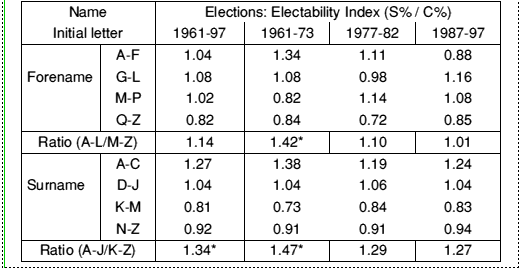
* P < 0.05
In 1961-73, excumbent forename and surname alphabetic biases were equally
convincing (P<0.05); but insignificant subsequently. Ironically in
1973, the Relative Electability Ratio for A-L / M-Z forenames (2.76)
exceeded that for A-J / K-Z surnames (1.57)! The pitfalls of generalising
from a single election are manifest.
District Magnitude
Surname disproportionality was virtually confined to four- and five-member
STV constituencies: only three-member constituencies returned TDs
more-or-less faithfully reflecting excumbent surnames (Table B).
Magnitude-specific surname A-J/K-Z Relative Electability Ratios proved
statistically insignificant, but much closer to unity in three-member
constituencies (1.25, 0.89 and 0.72) than in four-member constituencies
(1.62, 1.36 and 1.51), or in five-member constituencies (2.05, 1.77 and
1.42), in 1961-73, 1977-82 and 1987-97, respectively.
Table B: Excumbent Electability Index, by District Magnitude (seats per
constituency) and Surname initial letter: Irish Republic, 1961-97 (12
general elections: Dáil Éireann, 1962-98).
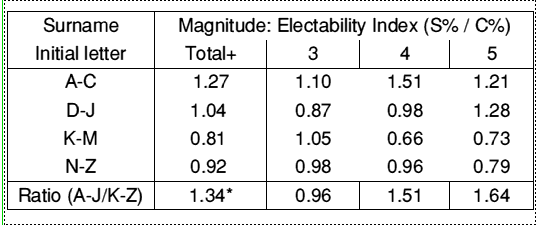
*P < 0.05
+Including a few two-member constituencies.
District Canditude and Position
Interestingly, the 1961-97 aggregate, excumbent Relative Electability Ratio
by surname (A-J/K-Z) proved identical with that by ballot-form position
(Upper/Lower = 1.34: P<0.05). Like the surname A-J/K-Z Relative
Electability Ratio with district magnitude (the number of seats per
constituency), the positional Upper/Lower Relative Electability Ratio
increased with district 'canditude' (the number of candidates per
constituency: Table C).
Table C: Excumbent Electability Index, by District Canditude
(candidates per constituency) and Ballot-form Position: Irish Republic,
1961-97 (12 general elections: Dáil Éireann, 1962-98).
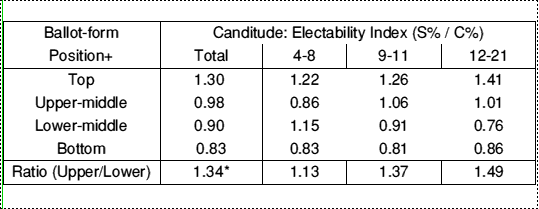
* P < 0.05 +Excluding odd-Canditude mid-candidates.
Party Policy
Both main political parties in the Irish Republic (Fianna Fáil and
Fine Gael) have staunchly denied over-nominating candidates appearing high
on ballot-forms[9]. Table D analyses the
surname-alphabetic distribution of FF and FG excumbent candidates, compared
with other (non-FF + FG) excumbents, in terms of a Relative Nomination
Index, over time.
Table D: Two Main Party Excumbent Relative Nomination Index, by
Elections and Surname initial letter: Irish Republic, 1961-97 (12 general
elections: Dáil Éireann, 1962-98).
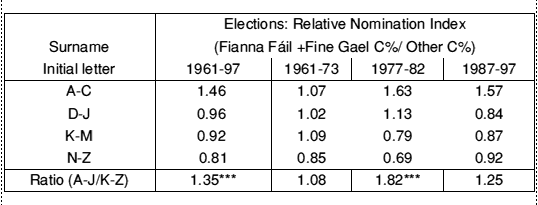
*** P < 0.001
Evidently since 1977, both main parties have greatly over-nominated A-C
surname candidates (and/or other parties have under-nominated them); with
the honours evenly divided between Fianna Fáil and Fine Gael.
Relative to the publication of Robson and Walsh (1974), the timing may not
have been entirely coincidental!
Electorate
Robson and Walsh (1974) observed that the alphabetic distribution of surname
initial letters differed insignificantly between randomly sampled Irish
electors and excumbent candidates at the 1973 Irish General Election.
Presumably nowadays, the surname initials of electors are rather
better represented by excumbent, non-FF + FG candidates; and Table E
compares overall seat-fractions, by surname initial, with excumbent, non-FF
+ FG candidate-fractions.
This Surname Concentration Index (Total S%/Excumbent, non-FF + FG C%)
highlights Dáil Éireann over-representing A-C surnames in the
Irish electorate; while under-representing K-M surnames. Despite the lower
surname A-J/K-Z Concentration Ratio since 1987 (1.35), A-C surname electors
remain over twice as likely as K-M surname electors to become TDs.
Table E: Surname Concentration Index, by Elections and Surname initial
letter: Irish Republic, 1961-97
(12 general elections: Dáil Éireann, 1962-98).
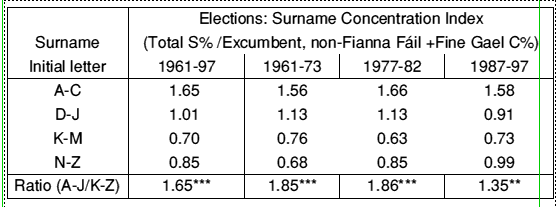
** P < 0.01 *** P < 0.001
Other STV Elections
Compared to the last 12 Irish general elections, with a total
surname A-J/K-Z Relative Electability Ratio of 1.26
(P<0.001), the last five European elections in the Irish
Republic (1979-99: Total S/C = 75/234) have yielded a
higher but statistically insignificant surname A-J/K-Z
Relative Electability Ratio of 1.37 (P > 0.05) [5].
On the other hand, the last five Irish Local Elections
(1979-99: Total S/C = 4,918/10,250) disclosed a lower
surname A-J/K-Z Relative Electability Ratio of 1.12
(P<0.001)[3]. Perhaps better acquainted with local
government candidates, voters discriminate more
individually; numbering their preferences regardless of
alphabetical order.
At the 1973 Assembly Election in Northern Ireland, Robson
and Walsh (1974) attributed eight out of 78 Seats to
positional voting bias. Yet at the 1998 Northern Ireland
Assembly Election (Total S/C = 108/296), the surname A-J/
K-Z Relative Electability Ratio fell below unity
(0.87: P>0.05)[4]. Certainly, parties are more sharply
differentiated in Northern Ireland than in the Irish Republic.
Discussion
Using forenames as controls, surname-alphabetic
electability valuably measures voters' lack of discrimination
between candidates within parties. Neither voters nor the
Irish electoral system (STV) can be reproached for any
positional voting bias.
However, Dáil Éireann remains surname-alphabetocratic,
over-representing candidates with A-C surnames, while
under-representing excumbents (non-incumbents) with K-M
surnames (Table A: compare Table E): especially in
constituencies with over three seats (Table B), and/or over
eight candidates (Table C).
Perhaps aware of Robson and Walsh (1974), Ireland's two
main parties (Fianna Fáil and Fine Gael) have apparently
over-nominated A-C excumbents (notably since 1977:
Table D). However, thus acting on the belief of increased
electability may itself increase A-C surname over-representation:
aggregating the last 12 Irish general
elections (1961-97), excumbent S%/C% for FF + FG (1.67)
was considerably higher than for other parties (0.43).
Reassuringly, aggregating all 12 general elections (1961-1997),
the excumbent Surname Relative Electability Ratio
(S/C ratio: A-J/K-Z=1.34 overall) proved significantly
higher for FF+FG (1.28: P<0.05) than for the other
candidates (1.03: P>0.05). however, it remains unclear
whether the two main parties have benefited from A-C over-nomination.
Darcy and McAllister (1990) found 'no evidence for
position advantage for political parties in any election'.
Their review concluded that positional voting bias may be
eliminated by removing its causes: notably, compulsory
voting; completion of all preferences; and ballot-forms not
indicating candidates' Party affiliation (as in Ireland before
1965[7]).
On the strength of the 1973 Irish General Election, Robson
and Walsh (1974) advocated randomising the order of
candidates on ballot-forms. Citing Robson and Walsh
(1974), Sinnott[8] suggested that the problem could 'easily be
eliminated by arranging the names in a number of different
randomised orders on different sets of ballot papers'.
At the Dublin High Court in 1986, Mr Justice Murphy
accepted that candidates with surname initials high in the
alphabet were over-represented but, noting that alphabetic
order helped voters to find candidates, he found it
constitutional[9]. Indeed, the voter's predicament is
paramount; and to avoid the palpable frustrations of
randomised ballot-forms in locating preferred candidates, a
reasonable compromise might be to print half the ballot-forms
in surname-alphabetic order, with the other half in the
reverse order — if positional voting bias really matters.
Acknowledgement
I am indebted to David Hill for statistical advice. Statistical
significance was calculated by combining election-specific,
one-tailed exact two-by-two table probabilities[6].
References
- Dáil Éireann (1962-98): Election Results and
Transfer of Votes in General Election: October 1961
— June 1997. Stationery Office, Dublin.
- Darcy R and McAllister I (1990): Ballot Position
Effects: Electoral Studies 9, 5-17.
- Department of the Environment and Local
Government (1980-2000): Local Elections, 1979-99.
Stationery Office, Dublin.
- Chief Electoral Officer for Northern Ireland (1998):
The New Northern Ireland Assembly Election 25
June 1998. Belfast.
- European Parliament Office in Ireland/Department of
the Environment and Local Government (1980-2000): European Parliament Election Results,
Ireland, 1979-99.
- Fisher R A (1970): Statistical Methods for Research
Workers, 14th Edition. Hafner Publishing Company,
New York (pages 99-101).
- Robson C and Walsh B (1974): The Importance of
Positional Voting Bias in the Irish General Election of
1973: Political Studies 10, 191-203.
- Sinnott R (1999): The Electoral System: in Coakley J
and Gallagher M eds: Politics in the Republic of Ireland
(Third Edition). Routledge, London (page 124).
-
Trench B et al (1987): The Alphabet Advantage: in
Magill Book of Irish Politics: Election February 87
(page 23).
Up: Issue 15
Next: Paper 2